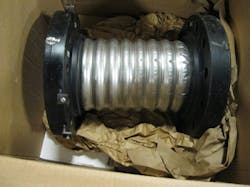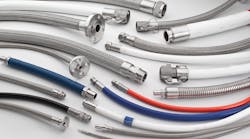A: Expansion joints are flexible components installed in a piping system to compensate for various movements, misalignment, and other forces. Metal expansion joints accomplish this by incorporating one or more metal bellows into the unit. These bellows are formed by introducing convolutions into a metal tube, allowing the bellows (and the expansion joint) to deflect laterally, axially, or at an angle. Unlike flexible hoses, expansion joints are capable of elongating or compressing axially in response to changes in length of the adjoining piping system due to thermal expansion. Expansion joints are typically found in steam piping systems, chemical process lines, air systems, and as exhaust bellows on various engines used for transportation or power generation.
Q: Why is it important for an end-user to understand expansion, contraction, deflection and offset movements? How do these movements apply to expansion joints?
A: Expansion joints can be designed in almost limitless configurations, but there are very specific design formulae that must be used in order to derive the optimal design for any given application. The STAMPED acronym can be used to identify all of the application variables that will be factored into the design of the expansion joint: Size, Temperature, Application (how used, anticipated movements, cycle life expectancy, etc.), Media, Pressure, End fittings, and Dynamics (of flow). The expected movement(s) must be accurately defined, and it is important to specify whether these movements occur independently or concurrently, as different design calculations apply. The three types of movement to which an expansion joint can be exposed are: angular deflection, lateral offset (where the ends remain parallel as the movement occurs), and axial movement (compression and elongation). Exposure to torsional stresses should be avoided. The best design is one that satisfies the STAMPED variables at a competitive price. Improperly designed expansion joints are either over-engineered (and therefore overpriced), or they are under-engineered and may be vulnerable to premature failure from bellows squirm, corrosion, or metal fatigue.
A: A well designed piping system does not prevent movements from occurring, but instead controls and directs those movements to a flexible piping component, such as a pipe loop, a slip-joint, or an expansion joint. Before an expansion joint can be designed, it is imperative that the forces acting upon it are clearly defined. Pipe anchors and pipe guides serve to isolate sections of piping so that any movements directed to the expansion joint are controlled and predictable. There are many different styles and configurations of pipe anchors and guides, and they must be carefully designed to resist all of the forces acting on them.
These forces may include:
• Spring force: The amount of force required to deflect the expansion joint, typically expressed in pounds per inch. These spring forces can be axial, lateral, or angular.
• Pressure thrust: The amount of force exerted on the piping system when the expansion joint is pressurized and attempts to elongate. Typically a much higher force than spring force.
• Pipe guide friction.
• Media flow, wind loading and other factors.
If the anchor point is not strong enough to restrain these forces, then the piping system (including the expansion joint) must be redesigned to prevent these forces from exceeding the limits of the anchors.
The content of this Q&A is based on the content of the Hose Master University training, which focuses on applications and best practices for specifying flexible metal hose and expansion joints for fluid handling scenarios.




